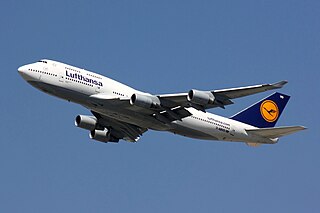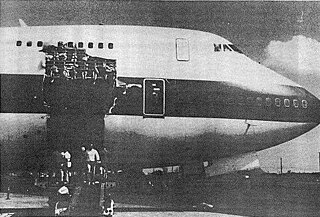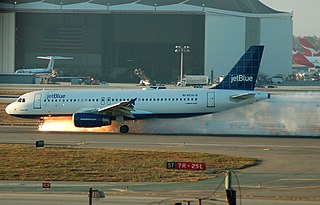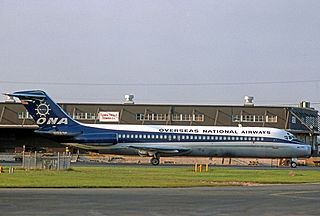British Airways plc (BA) is the flag carrier airline of the United Kingdom. It is headquartered in London, England, near its main hub at Heathrow Airport.

The Boeing 747 is a large, long-range wide-body airliner designed and manufactured by Boeing Commercial Airplanes in the United States between 1968 and 2023. After introducing the 707 in October 1958, Pan Am wanted a jet 2+1⁄2 times its size, to reduce its seat cost by 30%. In 1965, Joe Sutter left the 737 development program to design the 747. In April 1966, Pan Am ordered 25 Boeing 747-100 aircraft, and in late 1966, Pratt & Whitney agreed to develop the JT9D engine, a high-bypass turbofan. On September 30, 1968, the first 747 was rolled out of the custom-built Everett Plant, the world's largest building by volume. The first flight took place on February 9, 1969, and the 747 was certified in December of that year. It entered service with Pan Am on January 22, 1970. The 747 was the first airplane called a "Jumbo Jet" as the first wide-body airliner.

The Boeing 777, commonly referred to as the Triple Seven, is an American long-range wide-body airliner developed and manufactured by Boeing Commercial Airplanes. The 777 is the world's largest twinjet and the most-built wide-body airliner. The jetliner was designed to bridge the gap between Boeing's other wide body airplanes, the twin-engined 767 and quad-engined 747, and to replace aging DC-10 and L-1011 trijets. Developed in consultation with eight major airlines, the 777 program was launched in October 1990, with an order from United Airlines. The prototype was rolled out in April 1994, and first flew in June. The 777 entered service with the launch operator United Airlines in June 1995. Longer-range variants were launched in 2000, and first delivered in 2004.
Virgin Atlantic, a trading name of Virgin Atlantic Airways Limited and Virgin Atlantic International Limited, is a British airline with its head office in Crawley, West Sussex, England. The airline was established in 1984 as British Atlantic Airways, and was originally planned by its co-founders Randolph Fields and Alan Hellary to fly between London and the Falkland Islands. Soon after changing the name to Virgin Atlantic Airways, Fields sold his shares in the company after disagreements with Richard Branson over the management of the company. The maiden flight from London–Gatwick to Newark took place on 22 June 1984.
This is a list of aviation-related events from 1989.

The Boeing 787 Dreamliner is an American wide-body jet airliner developed and manufactured by Boeing Commercial Airplanes. After dropping its unconventional Sonic Cruiser project, Boeing announced the conventional 7E7 on January 29, 2003, which focused largely on efficiency. The program was launched on April 26, 2004, with an order for 50 aircraft from All Nippon Airways (ANA), targeting a 2008 introduction. On July 8, 2007, a prototype 787 was rolled out without major operating systems, and then the aircraft experienced multiple delays until its maiden flight on December 15, 2009. Type certification was received in August 2011 and the first 787-8 was delivered in September 2011 before entering commercial service on October 26, 2011, with ANA.

British Midland Flight 092, a Boeing 737-400, crashed onto the motorway embankment between the M1 motorway and A453 road near Kegworth, Leicestershire, England, while attempting to make an emergency landing at East Midlands Airport on 8 January 1989.

The Boeing 747-400 is a large, long-range wide-body airliner produced by Boeing Commercial Airplanes, an advanced variant of the initial Boeing 747. The "Advanced Series 300" was announced at the September 1984 Farnborough Airshow, targeting a 10% cost reduction with more efficient engines and 1,000 nautical miles [nmi] of additional range. Northwest Airlines became the first customer with an order for 10 aircraft on October 22, 1985. The first 747-400 was rolled out on January 26, 1988, and made its maiden flight on April 29, 1988. Type certification was received on January 9, 1989, and it entered service with NWA on February 9, 1989.
This is a list of aviation-related events from 1977.

United Airlines Flight 811 was a regularly scheduled airline flight from Los Angeles to Sydney, with intermediate stops at Honolulu and Auckland. On February 24, 1989, the Boeing 747-122 serving the flight experienced a cargo-door failure in flight shortly after leaving Honolulu. The resulting explosive decompression blew out several rows of seats, killing nine passengers. The aircraft returned to Honolulu and landed without further incident.

An emergency landing is a premature landing made by an aircraft in response to an emergency involving an imminent or ongoing threat to the safety and operation of the aircraft, or involving a sudden need for a passenger or crew on board to terminate the flight. It typically involves a forced diversion to the nearest or most suitable airport or airbase, or an off airport landing or ditching if the flight cannot reach an airfield. Flights under air traffic control will be given priority over all other aircraft operations upon the declaration of the emergency.

Helios Airways Flight 522 was a scheduled passenger flight from Larnaca, Cyprus, to Prague, Czech Republic, with a stopover in Athens, Greece. Shortly after take-off on 14 August 2005, air traffic control (ATC) lost contact with the aircraft operating the flight, named Olympia; it eventually crashed near Grammatiko, Greece, killing all 121 passengers and crew on board. It is the deadliest aviation accident in Greek history.

British Airways Flight 009, sometimes referred to by its callsign Speedbird 9 or as the Jakarta incident, was a scheduled British Airways flight from London Heathrow to Auckland, with stops in Bombay, Kuala Lumpur, Perth, and Melbourne.

ALM Antillean Airlines Flight 980 was a flight scheduled to fly from John F. Kennedy International Airport in New York City to Princess Juliana International Airport in St. Maarten, Netherlands Antilles, on May 2, 1970. After several unsuccessful landing attempts, the aircraft's fuel was exhausted, and it made a forced water landing (ditching) in the Caribbean Sea 48 km off St. Croix, with 23 fatalities and 40 survivors. The accident is one of a small number of intentional water ditchings of jet airliners.

China Airlines Flight 120 was a regularly scheduled flight from Taiwan Taoyuan International Airport in Taoyuan County, Taiwan to Naha Airport in Okinawa, Japan. On August 20, 2007, the Boeing 737-800 aircraft operating the flight caught fire and exploded after landing and taxiing to the gate area at Naha Airport. Four people—three from the aircraft and one ground crew—sustained injuries in the accident. The fire had been caused by a loose bolt puncturing a fuel tank.

As of July 2020, a total of 60 Boeing 747 aircraft, or just under 4% of the total number of 747s built, first flown commercially in 1970, have been involved in accidents and incidents resulting in a hull loss, meaning that the aircraft was either destroyed or damaged beyond economical repair. Of the 60 Boeing 747 aircraft losses, 32 resulted in no loss of life; in one, a hostage was murdered; and in one, a terrorist died. Some of the aircraft that were declared damaged beyond economical repair were older 747s that sustained relatively minor damage. Had these planes been newer, repairing them might have been economically viable, although with the 747's increasing obsolescence, this is becoming less common. Some 747s have been involved in accidents resulting in the highest death toll of any civil aviation accident, the highest death toll of any single airplane accident, and the highest death toll of a midair collision. As with most airliner accidents, the root of cause(s) in these incidents involved a confluence of multiple factors that rarely could be ascribed to flaws with the 747's design or its flying characteristics.

British Airways Flight 38 was a scheduled international passenger flight from Beijing Capital International Airport in Beijing, China, to London Heathrow Airport in London, United Kingdom, an 8,100-kilometre trip. On 17 January 2008, the Boeing 777-200ER aircraft operating the flight crashed just short of the runway while landing at Heathrow. No fatalities occurred; of the 152 people on board, 47 sustained injuries, one serious. It was the first time in the aircraft type's history that a Boeing 777 was declared a hull loss, and subsequently written off.

British Airways Flight 2069 was a scheduled passenger flight operated by British Airways between Gatwick, England and Jomo Kenyatta Airport, Nairobi, Kenya. At 05:00 on 29 December 2000, a mentally ill passenger stormed the cockpit and attempted to hijack the aircraft. The 747 stalled in the struggle. Captain William Hagan and his crew were able to apprehend the assailant while first officer Phil Watson regained control of the aircraft, bringing the situation under control.

British Airways Flight 2276 was a scheduled international passenger service from Las Vegas to London. On 8 September 2015, the Boeing 777-200ER operating the flight suffered an uncontained engine failure and fire in the left (#1) GE90 engine during take-off from Las Vegas-McCarran International Airport, prompting an aborted take-off and the evacuation of all passengers and crew. All 170 people on board survived, but 20 were injured.















